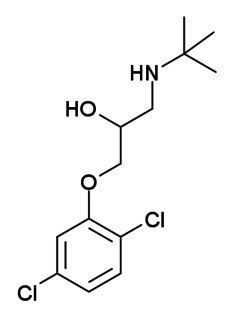
Bisoprolol, sold under the brand name Zebeta among others, is a beta blocker medication used for heart diseases. This includes high blood pressure, chest pain from not enough blood flow to the heart, and heart failure. It is taken by mouth.

The beta-3 adrenergic receptor (β3-adrenoceptor), also known as ADRB3, is a beta-adrenergic receptor, and also denotes the human gene encoding it.
Amibegron (SR-58,611A) was a drug developed by Sanofi-Aventis which acts as a selective agonist for the β3 adrenergic receptor. It is the first orally active β3 agonist developed that is capable of entering the central nervous system, and has antidepressant and anxiolytic effects.
Beta1-adrenergic agonists, also known as Beta1-adrenergic receptor agonists, are a class of drugs that bind selectively to the beta-1 adrenergic receptor. As a result, they act more selectively upon the heart. Beta-adrenoceptors typically bind to norepinephrine release by sympathetic adrenergic nerves and to circulating epinephrine. The effect of B-adrenoceptors is cardiac stimulation, such as increased heart rate, heart contractility, heart conduction velocity and heart relaxation.

Zinterol is a beta-adrenergic agonist.

Tretoquinol is a beta-adrenergic agonist.

Cyanopindolol is a drug related to pindolol which acts as both a β1 adrenoceptor antagonist and a 5-HT1A receptor antagonist. Its radiolabelled derivative iodocyanopindolol has been widely used in mapping the distribution of beta adrenoreceptors in the body.

ICI-118,551 is a selective β2 adrenergic receptor (adrenoreceptor) antagonist or beta blocker. ICI binds to the β2 subtype with at least 100 times greater affinity than β1 or β3, the two other known subtypes of the beta adrenoceptor. The compound was developed by Imperial Chemical Industries, which was acquired by AkzoNobel in 2008.

SR 59230A is a selective antagonist of the beta-3 adrenergic receptor, but was subsequently shown to also act at α1 adrenoceptors at high doses. It has been shown to block the hyperthermia produced by MDMA in animal studies.

Dihydroalprenolol (DHA) is a hydrogenated alprenolol derivative that acts as a beta-adrenergic blocker. When the extra hydrogen atoms are tritium, it is a radiolabeled form of alprenolol, which is used to label beta-adrenergic receptors for isolation.

Cloranolol (Tobanum) is a beta blocker.

Bufetolol is a beta-adrenoceptor antagonist.
Cicloprolol is a beta-adrenoceptor antagonist.

Exaprolol is a beta-adrenoceptor antagonist.

Pamatolol is a beta adrenergic receptor antagonist.

Primidolol is a beta adrenergic receptor antagonist.

Spirendolol is a beta adrenergic receptor antagonist.
Sulfinalol is a beta adrenergic receptor antagonist.

Capsinolol is a beta blocker derived from nonivamide. It is the first beta blocker with an associated calcitonin gene-related peptide releasing activity in the heart.

Eugenodilol is a alpha-1 blocker and beta blocker with weak β2-adrenergic receptor agonist activity derived from eugenol.
















